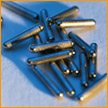| |
Description |
Advantages |
Disadvantages |
| Watchful
Waiting |
- No
treatment.
- Frequent
check-ups to evaluate condition.
|
- Avoid
the side effects of prostate cancer treatments.
|
- May
reduce the chance of controlling the disease before it spreads.
|
|
Brachytherapy

|
- An
outpatient procedure in which radioactive 'seeds' are carefully
placed inside cancerous tissue and positioned to attack
the cancer most effectively.
|
- Proven
to be very effective and safe.
- Provides
a good alternative to surgery while reducing the risk of
long-term side effects.
- New
technology has reduced radiation exposure hazards.
- The
optimum way of tailoring radiotherapy to the tumor without
harming surrounding normal tissue.
|
- Some
soreness and swelling in the treatment area. It is usually
mild and lasts for several days.
- May
experience frequent, urgent or uncomfortable urination -
symptoms that decrease in severity over time.
- A
small chance of becoming incontinent or impotent.
|
|
Cryoablation

|
- An
outpatient procedure that destroys cancer by freezing the
tumor and a surrounding rim of health tissue.
|
- Recent
studies show that 97% of cryosurgery patients are cancer-free
at 1 year and 82% are cancer-free at 5 years following surgery.
- Cryosurgery
usually can be repeated safely if cancer returns.
- A
safe, effective procedure for patients who cannot tolerate
surgery or radiation - and those who are elderly.
- One
of the few potentially curative treatments that can be offered
for localized prostate cancer recurrence after radiation
therapy or brachytherapy.
- Most
patients report very little discomfort and recover fully
within days.
- The
urethral warming device reduces incontinence or urethral
obstruction to about 1% of patients.
|
- There
is an 85% chance that nerve damage resulting from the freeze
will cause impotence. However, nerve-sparing techniques
are being developed to help reduce that risk.
|
| Surgery |
- Removal
of the prostate through an incision or incisions in the
back or perineum.
|
- For
patients in good health whose tumor is confined to the prostate.
- 10-year
survival rate ranges from 75% to 97% for patients in good
health.
|
- Possible
complications include rectal injury, incontinence, impotence
and heart failure.
- Dry
orgasms result.
- Lower
survival rate for patients with poorly differentiated cancers.
|
| EBRT |
- High-powered
linear accelerators send x-rays deep into the body to destroy
tumor cells by damaging their DNA.
|
- Often
effective for managing symptoms of cancer that has spread.
- Helpful
in relieving pain related to cancer that has spread to the
bones.
- A
short course of no longer than two weeks is sufficient in
most cases.
|
- Increased
urinary frequency. Mild burning with urination.
- Mild
diarrhea, gas, bowel urgency and tenderness.
- Bowel
irritability including mild irritation of the skin around
the rectum. About 20% of men experience more significant
long-term bowel irritability.
- Red,
dry, and tender skin in the treated area.
- Hair
loss.
- May
cause impotence.
|
| Radionuclide
Therapy |
- Radioactive
drugs are injected intravenously and absorbed by the bones.
|
- For
treatment of prostate cancer that has spread to the bones.
|
- Decreased
white and red blood cells possible, also platelets.
- Increase
in pain may occur in first days or week after treatment.
|
| Hormonal
Therapy |
- Drugs
and surgical procedures (including orchiectomy, or castration)
to block the male hormones that prostate cancer cells need
to grow.
|
- Prostate
cancer that has spread to other parts of the body can usually
be controlled for a period of time.
|
- Often
causes impotence, hot flashes and loss of sexual desire.
- Can
cause nausea, vomiting, diarrhea and breast growth or tenderness.
- Can
weaken bones in older men.
- May
cause liver problems.
|
| Chemotherapy |
- An
aggressive treatment using carefully controlled dosages
of drugs to destroy cancer cells.
|
- Can
improve symptoms and quality of life for men with advanced
prostate cancer.
|
- Many
side effects, including fatigue, nausea and vomiting, diarrhea,
hair loss and increased susceptibility to infection.
- Has
not proven very effective against slow-growing cancer cells.
|

